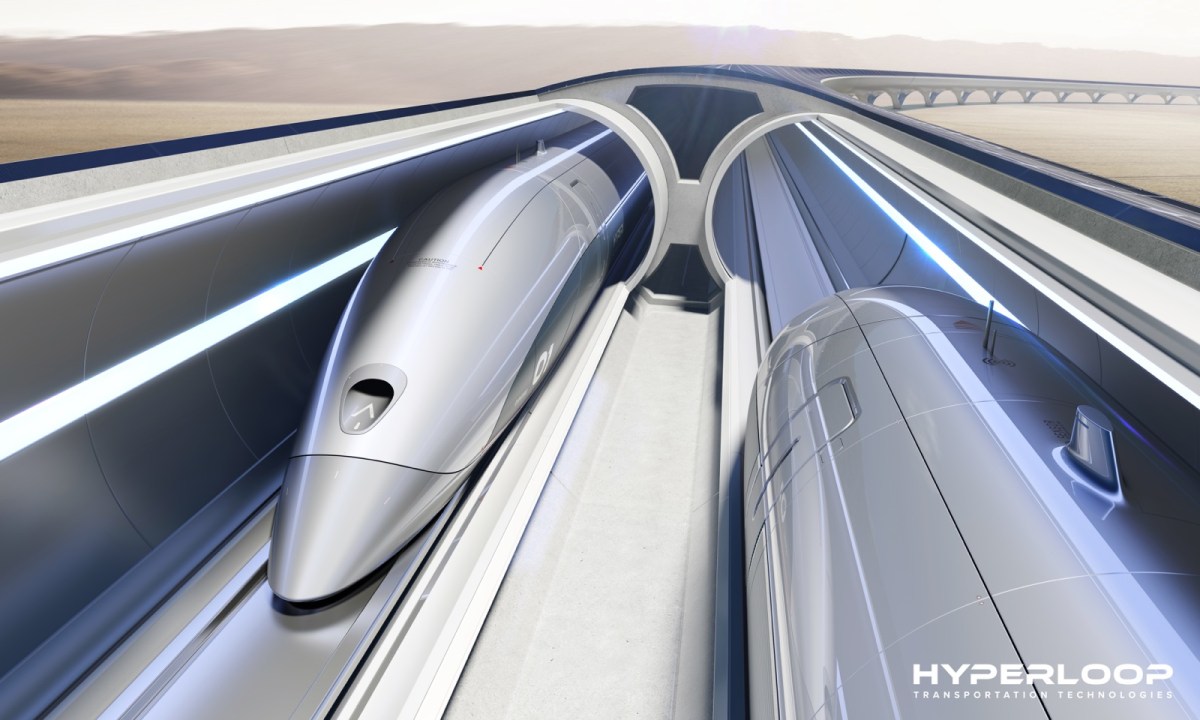
Hyperloop Transportation Technologies (HyperloopTT) has entered into a definitive merger agreement with special purpose acquisition company (SPAC) Forest Road Acquisition Corp. II, which is led by former Disney executives Tom Staggs and Kevin Mayer. The combined company will list shares at a pre-money valuation of $600 million.
In theory, hyperloop technology is a vacuum tube-based system that moves people and goods by levitating capsules at airplane speeds on the ground. The speeds are supposed to be achieved “by using passive magnetic levitation technology and a linear electric motor in a tube with minimal pressure, reducing resistance,” according to HyperloopTT. The goal is to provide a clean, safe, efficient form of transport.
Despite plenty of hype, money and many dazzling CGI renders, hyperloop technology still appears to be a pipe dream. The technology has never been proven at scale and even if it were, the services would probably be so expensive that they’d be loss-making for the company. Elon Musk’s The Boring Company is probably the most well-known advocate for hyperloop technology, but so far, all that TBC has to show for it is a tunnel in Las Vegas that ferries passengers in painfully slow moving Teslas.
So it’s quite surprising to see a SPAC deal on the horizon to bring a company with no near-term or probably even medium-term profitability to the public markets. In fact, given the specifics of the deal, the company will likely need to raise funds again immediately just to operate.
Right now, the deal is expected to provide the combined company with $330 million in net proceeds. That’s as long as the SPAC shareholders don’t withdraw their money before the deal closes. With redemption rates this year at an average of 81%, it’s more likely that in the best-case scenario, HyperloopTT will make out with around $70 million from the merger — that’s based on the $350 million cash in trust the SPAC has at the moment.
Yet even that projection might be rosy. Michael Ohlrogge, an assistant professor of law at New York University and co-author of the report, “A Sober Look at SPACs,” said HyperloopTT can also expect to pay about $20 million in transaction fees that would go to the banks working on the deal, not to mention the free shares going to the sponsor. What that would mean: The combined company would come away with less than $70 million, which is not nearly enough money to have a meaningful impact on scaling hyperloop technology.
“I see from the deal there is no PIPE. So, no sophisticated investors were willing to make any firm commitments to fund this deal,” said Ohlrogge. “My best guess is that they are just hoping that they’ll be able to find some unsophisticated investors who will fail to redeem their shares, thus handing over $10 per share for equity worth very little.”
HyperloopTT can still choose to cancel the merger if the SPAC has less than $40 million cash in trust, according to Ohlrogge, who noted the ability to cancel prevents the target from giving away millions of shares to the sponsor and millions to the banks if the SPAC ends up delivering essentially no money on the deal. A decision would need to be made quickly, as the SPAC is running up against its deadline and needs to complete the deal before March 2023.
“Given that it takes time for deals to come together, this is getting close to about as late as they could announce and possibly hope to close by then,” said Ohlrogge.
Some experts say that Forest Road Acquisition Corp. II is scrambling to close a deal, any deal, before its deadline. If it doesn’t, it’ll be forced to liquidate and give money back to investors. Note that last year Forest Road brought The Beachbody Company public, which ended up being a disaster for long-term shareholders.
In the third quarter, Beachbody reported revenue of $166 million, which is down 20% from Q3 last year, and a net loss of $33.9 million. The company’s stock is trading at $0.78, which is down nearly 69% year to date.
What HyperloopTT wants to achieve
Skepticism aside, HyperloopTT says it has developed a full scale test track in Toulouse, France, a hyperloop insurance framework model and safety and certification guidelines.
The company is working with the European Commission and the U.S. Department of Transportation on hyperloop system projects. For example, HyperloopTT is working on a feasibility study in the Great Lakes region in the U.S. and is working with Hamburger Hafen and Logistik AG to develop cargo hyperloop technology in Germany. The company is also trying to find a site in Canada to explore a commercial prototype including a three-mile passenger system and an R&D and experience center, the company says.
HyperloopTT is pursuing an “asset-light technology licensing business model” or “hyperloop-as-a-service” model, that can lead to three revenue streams, including a one-time license fee during system construction, annual license fees throughout the life of a system and annual take rate of sales.
It’s pretty clear that HyperloopTT and any of its derivatives have a long way to go before they can make a commercially viable product. Our best guess is another 10 years of R&D at least before we can even begin to think of hyperloop technology as more than vaporware. Which is what makes a SPAC deal today so confounding, especially when the appetite for such deals has waned substantially, particularly for pre-revenue companies.
HyperloopTT’s SPAC public debut may be going nowhere fast - TechCrunch
Read More
No comments:
Post a Comment